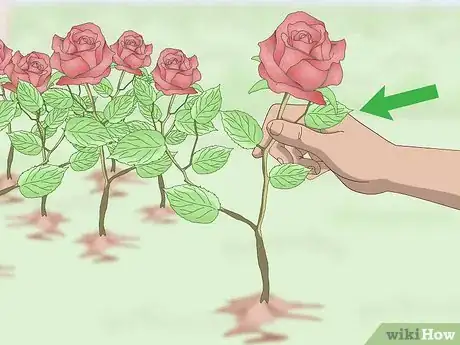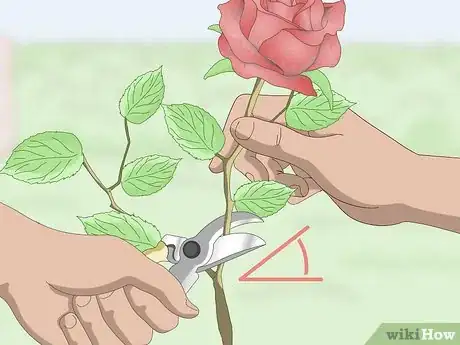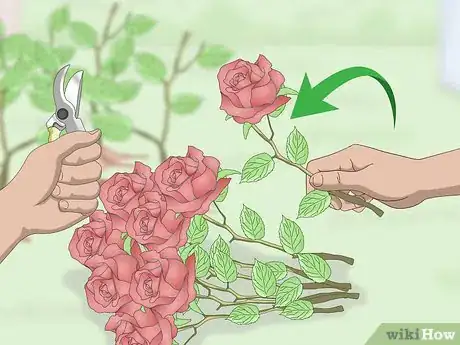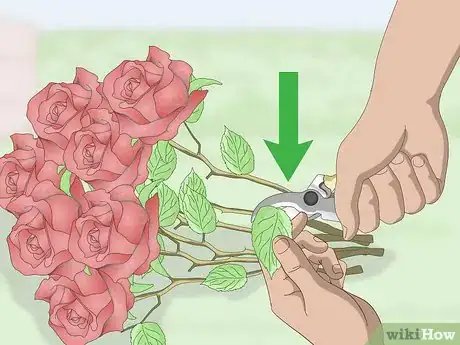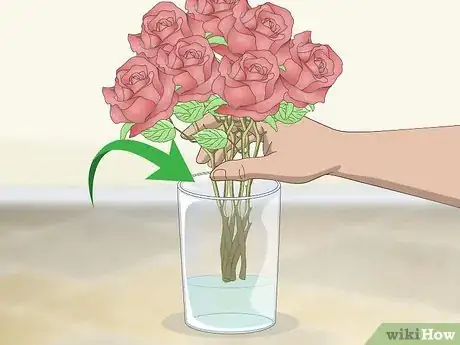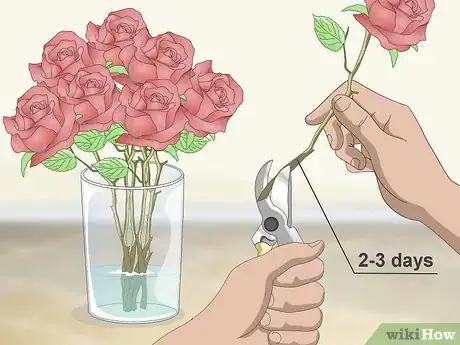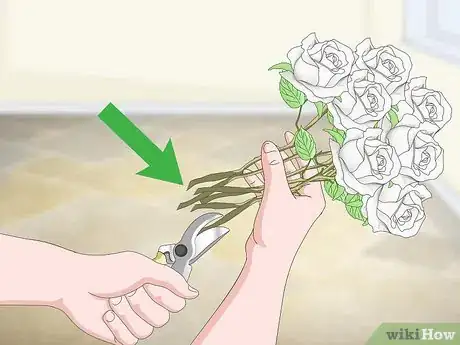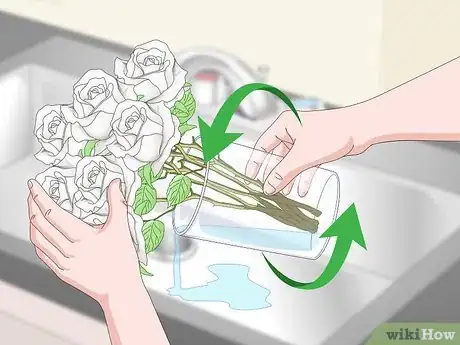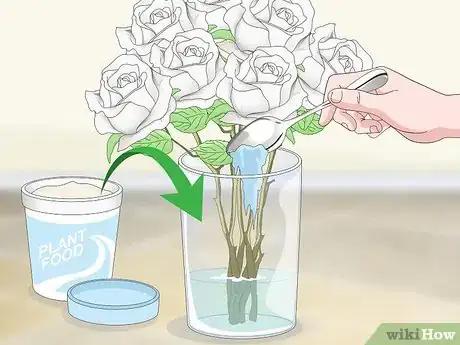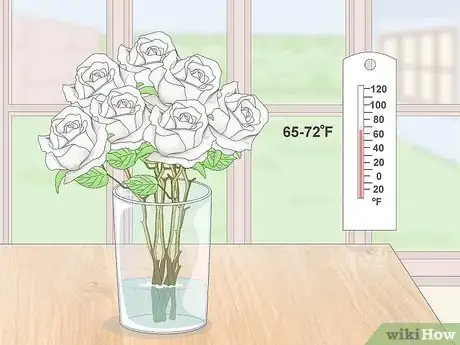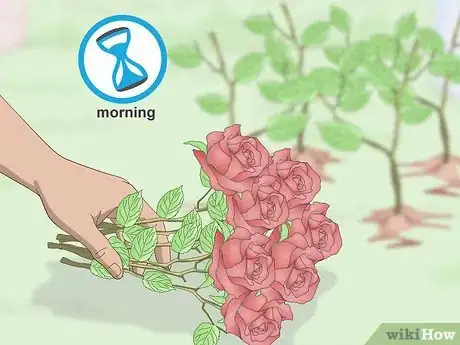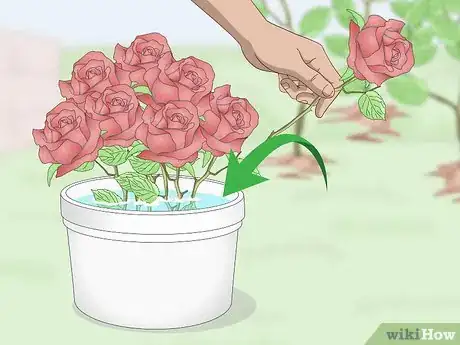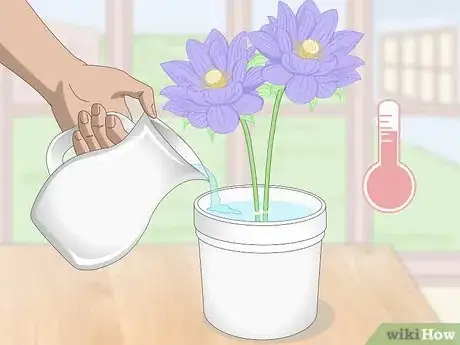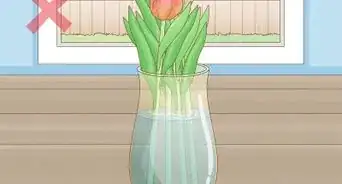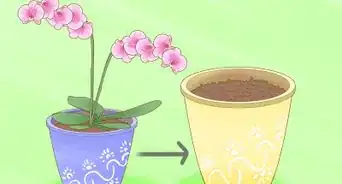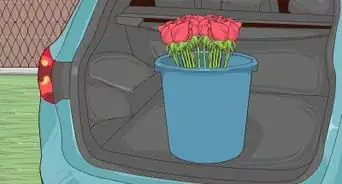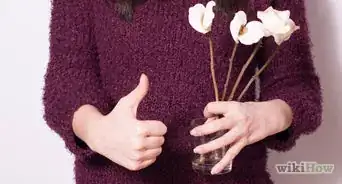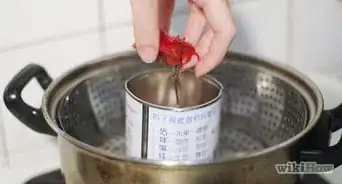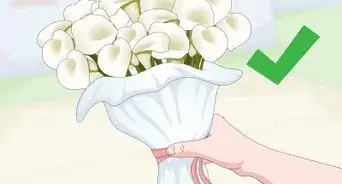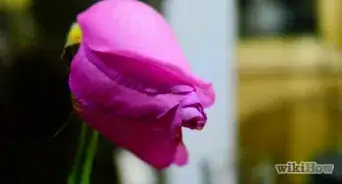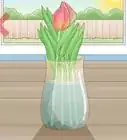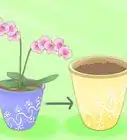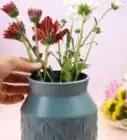This article was co-authored by Lauren Kurtz. Lauren Kurtz is a Naturalist and Horticultural Specialist. Lauren has worked for Aurora, Colorado managing the Water-Wise Garden at Aurora Municipal Center for the Water Conservation Department. She earned a BA in Environmental and Sustainability Studies from Western Michigan University in 2014.
There are 8 references cited in this article, which can be found at the bottom of the page.
This article has been viewed 22,763 times.
If you're not trimming your flowers before putting them on display, you're not enjoying them to their full potential. The whole process only takes a few seconds, but can add days to the lifespan of most garden-variety flowers. Simply snip the stems at a slight angle with a pair of pruning shears or sharp scissors, then place them in fresh water right away. By watering your cut flowers regularly, you can keep them looking great for up to a week.
Steps
Trimming the Stems
-
1Hold the flower beneath the blossom. Grip the stem lightly so as not to accidentally bend or strain it. For your own safety, there should be plenty of space between your hand and the section of the stem you'll be cutting.
- Avoid handling the delicate blossom itself.
-
2Snip the stem at a slight angle. Use a pair of pruning shears or sharp scissors to take off the bottom 2–3 inches (5.1–7.6 cm). Each cut should be performed quickly and neatly. An angled cut increases the exposed surface area of the stems, which will help them take in more water.[1]
- Make sure the tool you use is capable of making clean cuts. Mashing or otherwise damaging the stems can interfere with their ability to absorb moisture properly, which could cause them to go bad faster.[2]
Advertisement -
3Cut bunches of flowers individually. If you're cutting a handful of flowers for a bouquet or mixed arrangement, start by grouping them into a bundle. Make sure the stems are roughly an even length. Hold the center of the bundle, then separate and clip the stems one by one.
- You're more likely to harm the stems by attempting to cut several at one time.
-
4Remove the leaves from the bottom of the stem. Pluck the leaves by hand and use your pruning shears or scissors to clip thorns and other offshoots. Stripping the foliage below the waterline will prevent it from decaying and tainting the water. It also allows the flowers to cluster together better inside the vase.[3]
- Aim to clear the stems about halfway to two-thirds of the way up.[4]
-
5Place the flowers in a vase right away. Run fresh, room temperature water into the vase until it almost reaches the top. If possible, use a purified or distilled variety—the chemicals in tap water can leach vital nutrients from the flowers, causing them to die off faster. The stems can begin to reseal themselves in a matter of seconds, so make sure you get them into water as soon as possible.[5]
- It's important that the water be no warmer than room temperature, as elevated temperatures are bad for most flowers.
- Many florists recommend cutting fresh flowers under a stream of running water to expose them to moisture immediately. You might consider giving this method a shot if you want your flowers to last as long as possible.
-
6Trim the stems once every 2-3 days. After a while, the ends of the stems will grow dull and begin soaking up less and less moisture. Recutting them periodically keeps them healthy and hydrated. For each of your followup cuts, it will only be necessary to snip about 1⁄2 inch (1.3 cm) from the stem.
- Be sure to cut the flower above any visible brown or discolored spots. These could be signs of disease.
- Most people make the mistake of only cutting their flowers once. By maintaining them a little at a time, you stand to keep them alive for a week or longer (depending on the species).[6]
Preserving Fresh-Cut Flowers
-
1Cut precut flowers again as soon as you get them home. Anytime you pick up flowers from the store or florist, you'll want to refresh the stems by trimming them an additional half an inch or so, even if they've already been cut. This also applies to flowers that have been delivered or cultivated in a greenhouse.[7]
- To put it simply, always trim and prune fresh flowers, no matter where they came from.
-
2Change the water daily. Get in the habit of dumping out and replacing the water in your flower vase every morning, or as soon as it starts to get murky. Fresh flowers need a lot to drink, so don't hesitate to top off the water level if you notice it getting low. Be sure to add a pinch of plant food to help your flowers flourish.[8]
- To refill the water in large decorative arrangements, tilt the vase over the sink to empty it, then run fresh water over the stems using a watering can or measuring cup.
- Waiting too long between waterings can lead to rot, which causes the blossoms to wilt and produces an unpleasant smell.
-
3Add plant food to the water to keep the flowers nourished. Since cut flowers have been separated from their root system, they won't be able to survive as long as they would in the soil (no matter how fresh they are). You can prepare your flowers for their new environment by sprinkling half a packet of organic plant food into the vase prior to inserting them. Plant food contains essential nutrients as well as antimicrobial additives to slow the growth of mold and bacteria.[9]
- You can purchase plant food at any gardening center or greenhouse, or in the home-and-garden section of most supermarkets.
- Alternatively, you can whip up your own plant food at home by combining 1 tablespoon (14.8 ml) of sugar, 2 tablespoons (29.6 ml) of lemon juice, and 1 teaspoon (4.93 ml) bleach and adding them to 1 quart (0.95 L) water. Pour the mixture into the vase.[10]
-
4Keep your flowers somewhere cool. Most types of flowers fare best in mild, moderate conditions. Temperatures between 65 °F (18 °C) and 72 °F (22 °C) are ideal, though a couple of degrees higher or lower shouldn't make too much of a difference. Make sure your flowers get plenty of sunlight, but situate them away from the most intense glare to keep them from overheating.[11]
- Some heartier species like roses and orchids prefer a warmer environment. It's safe to store these flowers in hotter areas, such as your kitchen, or even outdoors on a sunny day.
- It's fine to keep your flowers' water at room temperature. You can also try adding a couple small ice cubes to the water, which may help the blooms survive a little longer.[12]
Taking Fresh Cuttings from Your Garden
-
1Gather fresh flowers first thing in the morning. The best time to put together a bouquet from your garden is early in the day before temperatures climb too high, while the flowers are firm and full of water. Avoid cutting flowers in the middle of the day—this is when they're the driest and therefore the weakest, so you'd effectively be starting off on the wrong foot.[13]
- If for some reason you're unable to gather your flowers in the morning, wait until the late evening hours when the temperature outside has cooled down considerably.[14]
-
2Store fresh-cut flowers in water. While cutting or picking fresh flowers, carry a bucket of room temperature water with you to keep them in until you can find them a more permanent home in a vase. The sooner they start taking in moisture after being separated from the root system, less chance there will be of them dehydrating and becoming wilted and sickly.
- If you're going to be in the garden for a while, take the flowers inside or leave them in a dim garage. It's better for them not to spend too much time in the hot midday sun.
- Refill the bucket between batches so you're not putting fresh flowers in the same murky water.
-
3Condition flowers with sappy stems. Some garden species (including poppies, poinsettias, and dahlias, to name a few) ooze a thick, milky sap when they're first cut, which makes it hard for the stem to take in water. The best way to deal with this is to place the flowers in hot water immediately after trimming them, or boil the lower ends of the stems for just a few seconds. Afterwards, you'll care for them the way you would any other flower.
- If you have a lighter handy, you can also wave the flame over the bottom of the stem briefly to “cauterize” it.
- Exposing the stems to heat destroys the cells that produce the sap so that water can filter through unimpeded.
Community Q&A
Did you know you can get answers researched by wikiHow Staff?
Unlock staff-researched answers by supporting wikiHow
-
QuestionHow can I help my cut flowers last longer?
 wikiHow Staff EditorThis answer was written by one of our trained team of researchers who validated it for accuracy and comprehensiveness.
wikiHow Staff EditorThis answer was written by one of our trained team of researchers who validated it for accuracy and comprehensiveness.
Staff Answer wikiHow Staff EditorStaff AnswerWhen you first place the flowers into a vase, use warm water to begin with. Then trim the stems an inch (2.5cm) from the base, on the diagonal to provide the maximum surface area for uptake of water. Keep the flowers in a cool and well-ventilated area. Keep ripe fruit away from the flowers because the ethylene gas it releases can speed up the demise of your cut flowers. For more help on keeping cut flowers longer, see How to Make Fresh Flowers Last Longer.
wikiHow Staff EditorStaff AnswerWhen you first place the flowers into a vase, use warm water to begin with. Then trim the stems an inch (2.5cm) from the base, on the diagonal to provide the maximum surface area for uptake of water. Keep the flowers in a cool and well-ventilated area. Keep ripe fruit away from the flowers because the ethylene gas it releases can speed up the demise of your cut flowers. For more help on keeping cut flowers longer, see How to Make Fresh Flowers Last Longer. -
QuestionWhich cut flowers last the longest?
 wikiHow Staff EditorThis answer was written by one of our trained team of researchers who validated it for accuracy and comprehensiveness.
wikiHow Staff EditorThis answer was written by one of our trained team of researchers who validated it for accuracy and comprehensiveness.
Staff Answer wikiHow Staff EditorStaff AnswerCut flowers that tend to last a long time in the vase include carnations, chrysanthemums, orchids, zinnia, alstroemeria, delphiniums, gladioli, lilies, sunflowers, peonies, dahlias, freesias, lavender, etc. Cut flowers can be kept longer if kept in a cool place that is well-ventilated and not near anything emitting ethylene gas, such as ripe fruit or dying flowers.
wikiHow Staff EditorStaff AnswerCut flowers that tend to last a long time in the vase include carnations, chrysanthemums, orchids, zinnia, alstroemeria, delphiniums, gladioli, lilies, sunflowers, peonies, dahlias, freesias, lavender, etc. Cut flowers can be kept longer if kept in a cool place that is well-ventilated and not near anything emitting ethylene gas, such as ripe fruit or dying flowers. -
QuestionDoes the temperature of the water matter for cut flowers?
 wikiHow Staff EditorThis answer was written by one of our trained team of researchers who validated it for accuracy and comprehensiveness.
wikiHow Staff EditorThis answer was written by one of our trained team of researchers who validated it for accuracy and comprehensiveness.
Staff Answer wikiHow Staff EditorStaff AnswerYes, the temperature does matter. When the cut flowers are first added to the vase, the best temperature of the water is lukewarm (just warm) because it has little air (which could end up as air bubbles trapped in the stem, preventing water uptake). It also prevents a shock of sudden immersion in too cold water.
wikiHow Staff EditorStaff AnswerYes, the temperature does matter. When the cut flowers are first added to the vase, the best temperature of the water is lukewarm (just warm) because it has little air (which could end up as air bubbles trapped in the stem, preventing water uptake). It also prevents a shock of sudden immersion in too cold water.
Warnings
- Watch out for the spiny thorns covering rose stems. Getting pricked doesn't feel good!⧼thumbs_response⧽
Things You'll Need
- Gardening shears or sharp scissors
- Fresh water
- Plant food
- Flower vase
References
- ↑ https://www.ftd.com/blog/design/cutting-flowers-for-vase-size
- ↑ http://www.westmountflorist.com/26-blog-the-right-way-to-cut-a-flower-stem.html
- ↑ https://www.bbg.org/gardening/article/cut-flower_care
- ↑ https://www.rhs.org.uk/advice/profile?PID=668
- ↑ http://www.westmountflorist.com/26-blog-the-right-way-to-cut-a-flower-stem.html
- ↑ http://www.growerdirect.com/flower-vase-life
- ↑ http://www.teleflora.com/blog/properly-cut-flower-stems/
- ↑ https://www.apartmenttherapy.com/5-tips-for-better-cut-flowers-157059
- ↑ https://www.rhs.org.uk/advice/profile?PID=668
About This Article
If you want to cut flowers, hold the stem just below the blossom and trim off the bottom 2-3 inches of the stem with pruning shears. Make sure you cut diagonally so you expose a larger part of the stem to help the flower take in more water. If you’re cutting a bunch of flowers, clip each stem individually so you don’t harm the stems by cutting them all at once. Then, trim off any leaves near the bottom of the stem so they don’t rot in the water before placing the flowers in a vase. After several days, chop 1/2 an inch off the stems to keep them fresh. To learn more from our Horticulturist co-author, like how to take fresh cuttings from your garden, keep reading the article!
